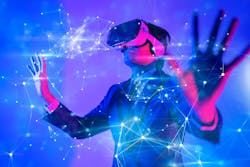In case it’s not obvious by how often I write about it, international standards are a passion of mine. Earlier this year, I was elected as the Canadian representative to International Electrotechnical Commission’s (IEC) Strategic Management Board (SMB). This not only means more meetings, but also attendance at the just completed 2023 general assembly, where many new and emerging technologies that will affect our work and lives are at various stages of renewal and development. This year’s emerging topics included the metaverse, bio-digital convergence, quantum technologies and artificial intelligence (AI) ecosystems.
The metaverse is a universal, immersive virtual world principally facilitated by virtual reality (VR), augmented reality (AR) and mixed-reality technology to enhance human life by extending it to virtual worlds. One example of a standard relevant to the automation and control realm is ISO/IEC 18038, which was developed by JTC 1/SC24 to define sensor information processing for representation in mixed and AR for operator training and real-time immersive simulations.
Bio-digital convergence, perhaps the most “sci-fi-esque” technology of the bunch, was approved as a new subcommittee to address technologies and applications that incorporate biological processes. These include digital technologies used to create new types of biofuels, biosensors or brain-machine interfaces. Already, scientists can mount microchips and sensors on cockroaches and other insects to control their movements by remote control. They can be used to help locate people trapped under the rubble of collapsed buildings. Another example is integrating technology into clothing to optimize the user’s workouts and report health data in real-time.
Based on the results of a 2021 whitepaper on quantum information technology, which describes quantum computing that may still be 10 to 15 years away from going mainstream, some of these technologies are already making an impact. They include quantum-key distribution and well-established commercial solutions. In the field of quantum sensing and metrology, several prototypes are under development, such as medical imaging solutions capable of detecting cancer cells that are five times smaller than present magnetic resonance imaging (MRI) machines can find. Recognizing the importance this technology will have in our future, SMB formally approved a new quantum technology subcommittee.
The ISO/IEC’s JTC 1/SC 42 subcommittee and its AI ecosystem standards include foundational standards, such as terminology and framework, guidance for application developers, governance of AI, AI data ecosystem, trustworthiness (including risk management), computational approaches, testing, functional safety and AI systems, and ethics.
These AI ecosystem standards are topical, particularly as the global discussion on responsible AI asks if ISO/IEC 42001 will be the standard for developing an AI system, so protocols to ensure responsible AI are followed. Also discussed was ISO/IEC 38507 on governance implications of the use of AI by organizations.
Each year, IEC’s market strategy board presents a whitepaper at the general assembly on a key technology. This year’s topic was “Power semiconductors for an energy-wise society,” which discussed the role of power semiconductors in deriving reliable power from single-digit direct voltages (DV) to more than 10 kV. Since these circuits are efficient, they’re suitable for applications in developing countries to help them make better use of their limited resources.
These emerging technologies are based on a range of expertise and are being developed jointly by IEC and ISO under the broad umbrella of Joint Technical Committee (JTC) 1. Some of the 22 information and communication technology areas in which IEC and ISO develop standards include AI, biometrics, cybersecurity, data management, and software and systems engineering. There are hundreds of committees at IEC working on everything associated with electrical technologies, explaining why there are multiple IEC digital and electric society initiatives supporting United Nations’ 17 Sustainability Goals.
Though there’s plenty of work being done by IEC to support 5G and its safe use, the technology is more an International Telecommunication Union (ITU)-related topic. Though still a nascent technology, 5G is gaining widespread acceptance, and the various use cases it makes possible are just beginning to be realized. It’s no longer on the “emerging topic” list. However, with the 6G standard in development, cellular technology may soon return to the list.
For more information on how standards improve day-to-day life, and turn many science-fiction concepts into reality, several white papers, infographics, strategic plans are available at IEC Basecamp.
About the Author

Ian Verhappen
Ian Verhappen

Leaders relevant to this article:
